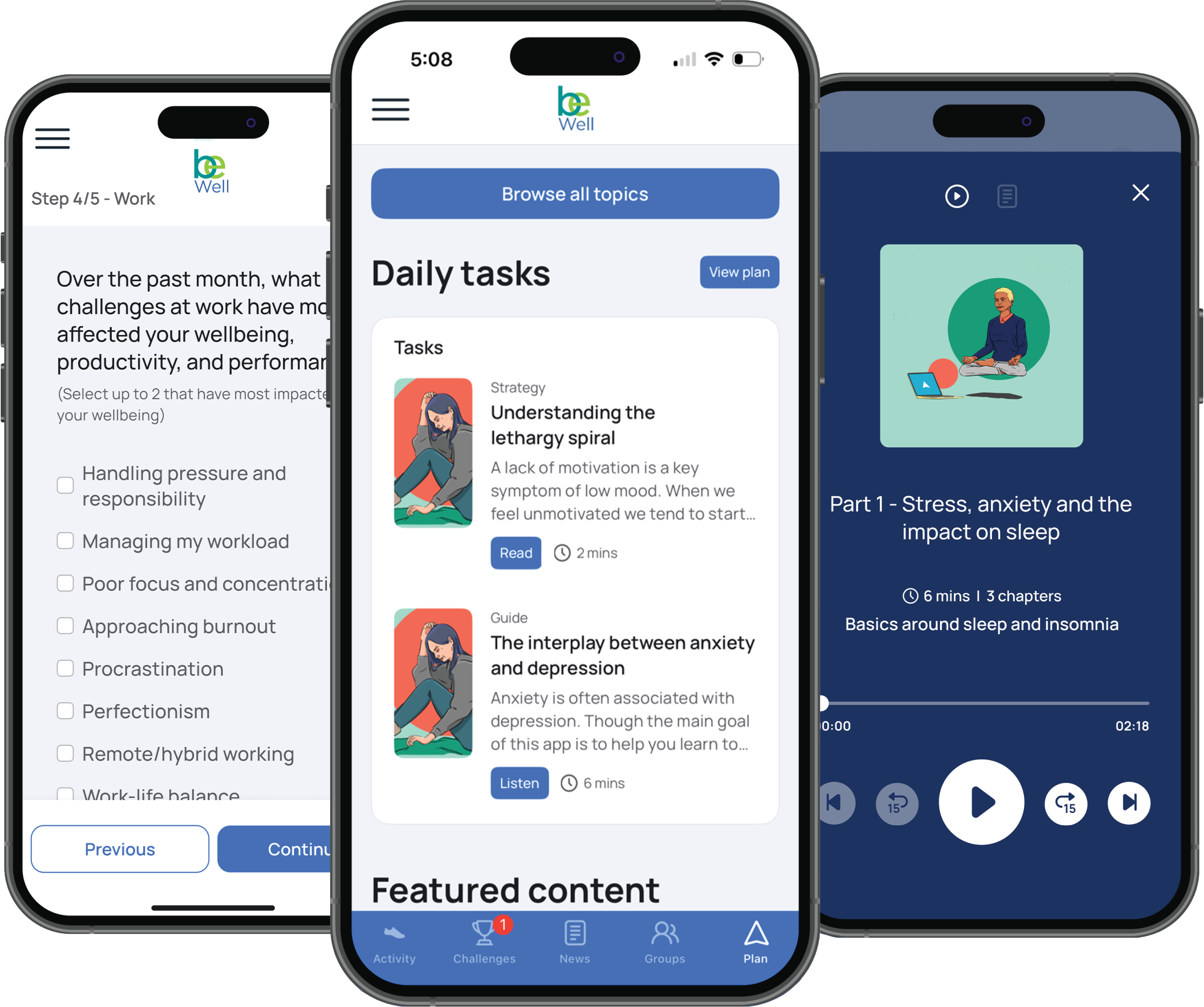February 4, 2025

In today's fast-paced world, where sedentary lifestyles are becoming the norm, it's more crucial than ever to find creative ways to promote employee health and well-being.
Workplace step challenges, or walking challenges, are a fantastic initiative that can engage your team, boost morale and camaraderie, and motivate everyone to embrace a more physically active lifestyle.
Not only does it promote physical wellness, but it can also improve mental health and overall workplace productivity. Step challenges are a classic corporate wellness initiative, and for good reason.
These challenges can easily be adapted, making them simple, inclusive, accessible, and effective for improving employee wellbeing and health.
If you’d like to start a office step challenge at your company, here’s everything you need to know to run a successful office step challenge.
What is a Step Challenge?
First, let’s clarify what a walking challenge is. A corporate walking challenge is oftentimes initiated as a part of an overall corporate wellness campaign.
Wellness campaigns tend to touch on several areas of well-being, like physical and mental health and wellness, social wellness, financial wellness, and physical wellness.
Therefore, a step challenge is an initiative primarily aimed at improving employees’ physical wellness, however, physical well-being and mental health are typically closely linked.
Companies can also opt for either an individual or team step challenge to participate and encourage employees to walk (or move) more than they were previously.
Step challenges usually take place during a specific time period and have goals and targets set by the comprehensive wellness program coordinator.
Companies can also opt for either an ongoing step challenge structure, where different challenges occur throughout the year. Or, some companies prefer to choose a one-time step challenge, dedicated to a specific event.
3 Best Corporate Step Challenge Apps
1. Terryberry's Be Well:
Terryberry knows that every company has a range of people - from wellness novices to fitness fanatics - which is why our wellness platform, Be Well, emphasizes inclusivity. With features like our activity converter, employees are free to move however works for them. Our all-in-one platform helps teams develop healthy habits for their bodies and minds.
- Activity Challenges - Organize engaging challenges that encourage team bonding and improve overall well-being. Travel the globe with our unique and engaging map-based challenges and interact with fellow participants through leaderboards that also track progress. Plus, we developed an easy-to-use activity converter that allows users to move how they choose, making wellness accessible for all ability levels, body types, and interests.
- Personalized Well-Being Plans - Be Well offers personalized well-being plans that support both physical wellbeing and mental well-being. Whether it’s stress, anxiety, or a struggle with focus, participants get to tailor their plans specifically to their challenge areas.
- Well-Being Workshops - We deliver expert-led online training to help improve and sustain the mental well-being of you and your team, and we back it up with our support team to help with even the toughest workplace challenges too. Expert-Led Training Support employees’ mental well-being by accessing our library of 150+ expert audio guides across 40+ mental health topics
- Wearable & App Integration – Syncs with Fitbit, Apple Health, Garmin, Google Fit, and other health tracking devices and apps.

2. Wellable
Wellable is a corporate wellness platform that helps companies run health and fitness challenges, including step challenges, while integrating with various wellness initiatives. It allows employees to track physical activity, nutrition, mindfulness, and more.
- Step & Activity Challenges – Tracks steps and converts other activities (cycling, swimming, etc.) into step equivalents.
- Wearable & App Integration – Syncs with Fitbit, Apple Health, Garmin, Google Fit, and other health tracking devices and apps.
- Customizable Challenges – Companies can create branded wellness campaigns with leaderboards and incentives.
3. Virgin Pulse
Virgin Pulse is a corporate wellness platform that helps companies improve employee well-being, engagement, and productivity through a variety of health and lifestyle programs. It offers a comprehensive suite of tools that go beyond just step challenges to include mental health, nutrition, sleep, and financial well-being.
- Personalized Wellness Journeys – Employees get customized health plans based on their individual goals.
- Step & Activity Challenges – Supports team-based and individual step challenges with leaderboards and rewards.
- Wearable & App Integration – Syncs with Fitbit, Apple Health, Google Fit, Garmin, and more.

Benefits of Corporate Step Challenges
There are plenty of reasons to try encouraging physical activity at work – reduced sick days, lower health care costs, increased productivity - but step challenges in particular can be a great option for workplace wellness.
This is because these challenges also offer several benefits for both employees and employers. Here are some of the key advantages:
Promotion of Physical Activity:
- An office walking challenge encourages employees to engage in regular physical activity, promoting a healthier lifestyle.
- A simple daily walk combats sedentary behavior, which is associated with various health risks, including obesity and cardiovascular diseases.
Improved Employee Health:
- Regular physical activity has been linked to amazing benefits, such as improved overall health, reduced stress, and increased energy levels.
- May lead to a decrease in absenteeism due to illness, as healthier employees are generally less prone to sickness.
Enhanced Team Building:
- Walking challenges foster a sense of camaraderie and teamwork among employees as they work together toward a common goal.
- Walking can facilitate social interactions outside of regular work tasks, contributing to a more cohesive work environment.
Increased Morale and Motivation:
- Achieving personal and team-based fitness goals can boost individual morale and motivation.
- Recognition and rewards for participation or achievements in the challenge can further motivate employees.
Stress Reduction:
- Physical activity is known to reduce stress and improve mental well-being.
- Incorporating an office step challenge can create a positive outlet for stress relief.
Cost-Effective Wellness Program:
- Compared to some other wellness programs, step challenges are relatively cost-effective to implement.
- The cost of organizing such challenges may be outweighed by the long-term benefits to employee health and productivity.
Data-Driven Insights:
- Many step challenge platforms provide data and analytics that organizations can use to track participation rates and overall employee health trends.
- This data can inform future wellness initiatives and help organizations tailor their programs to better meet employee needs.
Employer Branding:
- Demonstrates a commitment to employee well-being and a positive workplace culture, which can enhance the employer's brand and attract talent.
Measurable Impact:
- The quantifiable nature of step challenges allows organizations to measure the impact of the program in terms of increased physical activity, improved health metrics, and overall employee satisfaction.
Additionally, research has shown walking challenges to be widely beneficial for developing healthy habits.
A study done by the University of Edinburgh looked at the effectiveness of the Step Count Challenge, an annual, nationally-delivered workplace step challenge. They found that a whopping 93% of participants experienced benefits.
The top 3 benefits reported were better physical health, increased team morale, and greater personal enjoyment. Furthermore, participants’ weekly activity levels increased by an average of nearly 2 hours for transportation purposes and nearly 1 hour for leisure. But wellness isn't just beneficial to the employee either.
One study by Gallup found that employees whose wellbeing is valued, show 21% greater profitability and markedly lower rates of employee turnover and absenteeism.
Additionally, a study by Towers Watson and the National Business Group on Health found that organizations with highly effective wellness programs report significantly lower voluntary attrition than those whose programs have low effectiveness (9% vs. 15%).
So, while there are clear physical benefits from corporate step challenges, there are also financial benefits for organizations as well.
How to Start a Workplace Step Challenge
Doing a step challenge at work may be a simple concept, but it still requires time, energy, and planning to ensure they run smoothly.
To help you get your wellness challenge started, we’ve outlined our best practices for starting a workplace step challenge.
1. Set Your Parameters
Begin by defining what you aim to achieve with your office step challenge.
Whether it's to increase physical activity levels, encourage team bonding, or simply inject some fun into the workplace, having clear objectives will help guide your planning process.
Setting parameters means establishing the framework your fitness and wellness challenges will exist within.
This includes establishing:
- How long the challenge will last
- Whether it’s individual or team challenges
- What the goal is (i.e., a 7,000 step count per day, per person)
- Where information will be housed, like a wellness app
- What is the criteria for winning and what will the winner(s) receive
Setting up step challenges in Terryberry's Be Well app is easy. Start with preset challenges or create custom challenges of your own with daily step goals and length of time the challenge will last.
Then, you’ll need to communicate this information to the team.
Don’t forget to ensure remote and shift workers are included and able to participate as well – if your challenge isn’t inclusive, it isn’t ready to go live.
Terryberry customers work with their customer success manager to plan different and unique step challenges seasonally or throughout the year, as well as set parameters, and provide strategies to increase user engagement.
2. Choose Your Platform
In the past, step challenges were typically done through pedometers or carrying around a smartphone. However, today we have an endless supply of wearable devices to suit people's unique needs.
Similarly, there are also numerous apps and platforms designed to track steps and facilitate workplace step challenges.
You may also want to consider a platform that goes beyond step challenges and offers mental well-being resources, as well. Tying your wellness challenge platform to a rewards and recognition platform can be another great way to boost engagement, participation, and greatly reduce the amount of administration, IT compliance, and billing of different vendors and platforms.
Terryberry offers activity and step challenges for companies of all sizes. Employees can travel to real-world locations around the globe with our unique and engaging map-based challenges. Conduct an individual or team challenge where participants can interact with fellow challenge participants through leaderboards that also track progress.
Terryberry's platform houses step challenges, mental wellbeing, recognition, and rewards all in one place, allowing you to start with what you need now and easily add solutions as your employee engagement goals expand.
3. Share Progress Reports
Another great and fun way to keep your step challenge thriving is by sharing progress with the whole company. This can help build camaraderie and friendly competition, but it also shows that employee wellness programs is something the company itself truly values.
There are a few ways to highlight progress reports. While you can show the entire leaderboard, you may want to avoid doing so if your challenge isn’t team-based.
Instead, you may want to show only the top 3-10 people. This helps stimulate healthy competition, without embarrassing or discouraging anyone who may be early in their fitness journey.
Also consider sharing different types of progress to help employees compete in different ways. Acknowledge and celebrate wins like “most improved,” “most consistent,” “most variety in activities tracked.”
4. Offer Worthwhile Rewards
While you will likely have people who will participate in a step challenge regardless of a reward, you will also have those who are motivated by a prize. Consider what type of prize you’ll offer, as well as your prize structure.
This is to say, will there be a first, second, and third place prize? Or will you give a prize for most improved, most team spirit, or best team name? Maybe consider drawing a random winner out of all the participants to help encourage participation and effort.
Just be sure your prize is something your employees value. This could be extra PTO day(s), a gym membership, exercise equipment, or extra points to redeem on a social recognition platform – the options are endless.
Lastly, be sure to announce winners to the whole company. Take a moment to celebrate the winners, as well as everyone who participated. After all, any step towards good health and increasing physical activity is worth celebrating.

How to Boost Employee Step Challenge Participation
As mentioned, employee participation is critical for any successful office step challenge. Help boost engagement with our 4 tips.
1. Focus on Inclusivity
Successful wellness programs engage a wide audience. To reach maximum participation, your step challenge needs to be accessible to everyone in your company, no matter how they move, where they are, what equipment they have access to, or where their starting point is.
To help truly build life-long healthy behaviors and habits, think in terms of the lowest common denominator of employee health and wellness.
Meaning, people who run marathons, play sports, or do Crossfit 6 days a week are going to engage in their physical fitness regardless of a corporate step challenge.
Instead, focus on engaging the people who wouldn’t otherwise begin their fitness journey. Perhaps they’re intimidated by the gym, don’t know where to start, or have limited access. Thinking through an inclusive lens will help drive participation for your step challenge throughout your entire population.
Additionally, it’s important to ensure all team members feel they can participate in your walking challenge. This means being accessible to people of all skill and ability levels, which is where activity converters come in handy.
Activity converters allow you to honor any type of movement - not only steps- into your step challenges, from yoga to scuba diving. These converters are an integral aspect to the inclusivity of your program and to following ADA requirements.
2. Communicate
A 2012 Gallup poll found that 85% of large US companies offered a corporate wellness program but only 60% of employees in those companies knew the programs existed. To make matters worse, only 40% of those that knew about the programs actually participated in them.
Simply put, if you're looking for maximum participation, your team should know exactly what initiatives are happening, when they're occurring, and how to get involved.
This can be easily achieved through email communications, in-office posters, and your company online dashboard if you have one. Also, encourage your leaders to mention wellness and health initiatives in their staff meetings.
Additionally, these communications should include information regarding:
- Why a specific program was chosen for your company.
- How to navigate the program platform (videos go a long way here!).
- Informational wellness content related to a current challenge.
- All aspects of health, including physical, mental, and emotional.
3. Check in Regularly
What better way to increase step challenge participation than to ask your employees what they want from their program?
There's no one better to tell you what people need in a wellness program than those who are using it. Send out employee pulse surveys specifically focused on your wellness initiatives, like step challenges.
Employee engagement surveys are a great way to get feedback from your team and learn what's working well, what could be different, and get ideas for a future walking challenge. By asking the right questions, you can also learn about what motivates your employees and increase your wellness program participation.
These surveys can also help you identify problems in your program early on before they become bigger issues. Another way to stay in touch with employees during a step challenge, is to send push notifications.
Depending on the platform you chose for your challenge, you'll likely be able to send reminders, tips to improve employee health, updates directly to employees' phones, as well as reminders throughout each day to move.
This can also help engage employees and remote workers. Just be sure to allow people to opt out – you don’t want to pressure employees or become a nuisance.
4. Get Leadership Buy-In
Possibly the simplest way to generate excitement in your step challenge at work is to encourage leadership buy-in.
Because company leaders are the ones who primarily set the tone for office norms, they play a pivotal role in whether wellness indicatives are embraced or discouraged.
Sending emails late at night, choosing to utilize PTO, encouraging team-building activities are all actions that set the tone for team culture and expectations. And wellness is no different.
When employees see leaders taking a step challenge seriously, they then feel safe to embrace the step goals for them too.
You may notice employees experimenting with walking meetings or taking afternoon walking breaks together. These are great signs your efforts are being embraced and adopted by the team.
Next Steps

Starting a workplace step challenge can breathe new life into your office environment, encouraging colleagues to lace up their sneakers and embrace a healthier way of living.
By fostering a sense of community, using positive habits, promoting wellness, and injecting a dose of fun into the daily routine, you're not only boosting the physical health of your team but also creating a more engaged and motivated workforce.
So, take that first step towards a healthier, modern workplace – your employees will thank you for it!
If you’re interested in running your own step challenge, get started with Terryberry’s Be Well app today.


